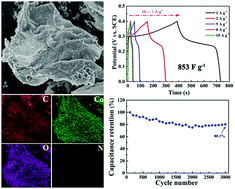N-Doped celery-based biomass carbon with tunable Co3O4 loading for enhanced-performance of solid-state supercapacitors†
Abstract
Celery biomass carbon supercapacitor electrodes with tunable Co3O4 loading are designed through an oxidation-precipitation and crystallization process of Co ions. The Co3O4 particles are uniformly decorated on the surface of the sheet-like celery carbon. The secondary large particles tend to be agglomerated with the increase of Co3O4 loading and the specific surface area decreases. Among the celery carbon and celery/100%Co3O4, celery/150%Co3O4, celery/200%Co3O4, celery/250%Co3O4, and celery/300%Co3O4 composites, the celery/150%Co3O4 composite provides the best specific capacitance of 853 F g−1 at a current density of 1 A g−1, and it maintains 80.1% of the initial specific capacitance after 3000 cycles. The energy density for the hybrid device reaches 11.8 W h kg−1 at a power density of 375 Ws kg−1. The N-doping shows an important impact on the specific capacitance of the composites. This study provides guidance for designing biomass carbon-based electrode materials.



 Please wait while we load your content...
Please wait while we load your content...